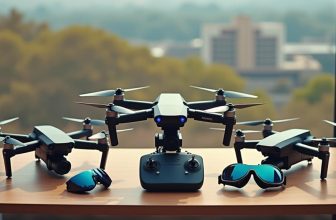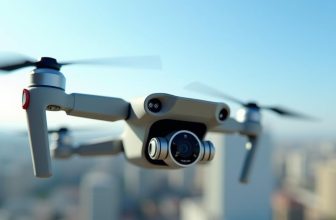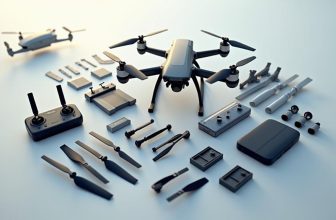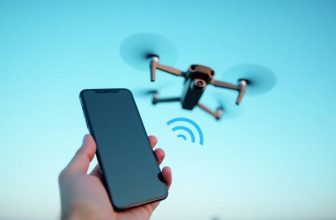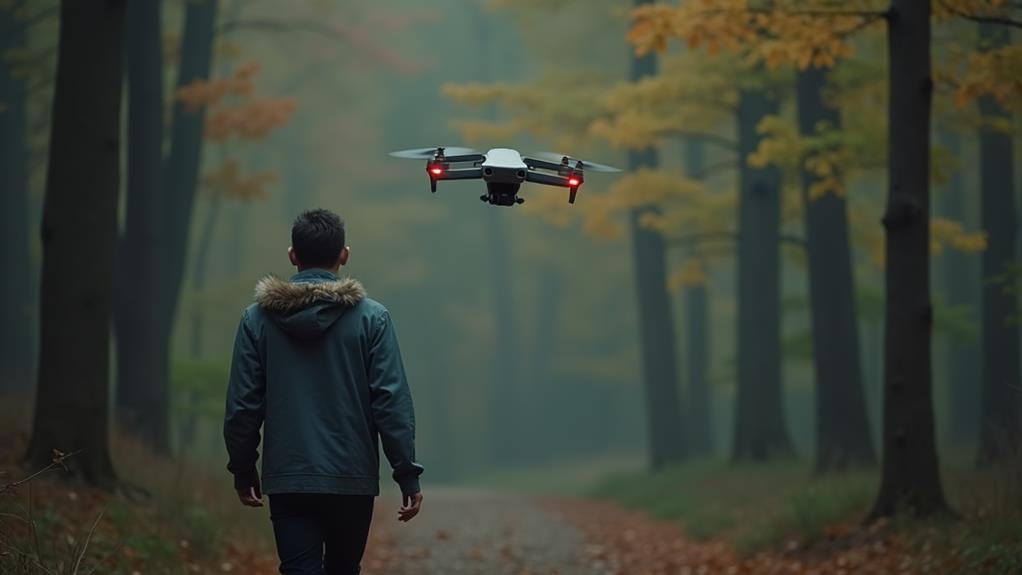
You're walking down the street, and you notice a faint humming noise above you – it's not uncommon, but what if that noise isn't just from a passing airplane or helicopter? Advances in drone technology have made it easier for these devices to blend in with their surroundings, raising concerns about unwanted surveillance. As you continue on your daily routine, you can't help but wonder: could that drone be following me? With the rising use of drones in various industries and by individuals, understanding the signs of drone surveillance is vital – but where do you even start?
Contents
- 1 Key Takeaways
- 2 Drone Tracking Capabilities Explained
- 3 Reasons for Drone Surveillance
- 4 Signs of Drone Stalking
- 5 Drone Laws and Regulations
- 6 Who Can Use Drones Legally
- 7 How to Identify a Drone
- 8 Drone Detection Methods
- 9 Protecting Your Personal Space
- 10 Countering Drone Surveillance
- 11 Frequently Asked Questions
- 12 Conclusion
Key Takeaways
- Visible clues of a drone following you include its distinct shape, noise pattern, and hovering or rapid changes in direction.
- Check for unusual flight behavior like repeating specific patterns, circling, or zigzagging, which can indicate surveillance or tracking.
- Drones can be identified by their rotor design, camera placement, and body shape and size, which differentiate them from other flying objects.
- If you suspect a drone is following you, remove or cover identifying objects and use a drone-detection app to scan the area.
- If feeling threatened or harassed by a drone, contact local authorities and consider using countermeasures such as frequency jamming devices or physical barriers.
Drone Tracking Capabilities Explained
A drone's ability to track and follow an individual or object is largely dependent on its equipped sensors and tracking capabilities.
You might be surprised to learn that these capabilities can be greatly enhanced through drone upgrades. High-resolution cameras, GPS systems, and advanced sensors such as lidar or radar can substantially improve a drone's tracking abilities.
When considering the implications of drone tracking, you should also think about surveillance ethics.
As drones become more prevalent, concerns about invasion of privacy and misuse of surveillance technology are growing. Crucially, you must weigh the benefits of drone surveillance against potential risks to individual privacy and security.
In technical terms, a drone's tracking capabilities can be broken down into two main components: object detection and object tracking.
Object detection involves identifying a target object or individual, while object tracking involves following the target over time.
Advanced algorithms and machine learning techniques can be used to improve a drone's object tracking capabilities, making it more effective at following and monitoring its target.
Reasons for Drone Surveillance
Now that you understand the advanced tracking capabilities of drones, you're likely wondering why someone would use this technology to follow an individual or object.
One of the primary reasons is that drones offer numerous benefits, including increased efficiency, cost-effectiveness, and flexibility.
For instance, surveillance drones can be deployed in areas that are difficult or hazardous for humans to access, such as disaster zones or remote wilderness areas.
Additionally, drones equipped with advanced sensors and cameras can capture high-quality data and footage, making them ideal for applications like environmental monitoring, wildlife tracking, and infrastructure inspection.
However, the use of drones for surveillance also raises concerns about ethics.
As drones become increasingly sophisticated, there's a growing need to establish clear guidelines and regulations for their use.
This includes ensuring that drones are used in a way that respects individuals' right to privacy and that surveillance is carried out in a transparent and accountable manner.
Signs of Drone Stalking
Frequently, individuals who suspect they're being followed by a drone are left wondering if their concerns are justified.
If you're experiencing unusual drone activity near your home or during your daily routine, there are signs to look out for that may indicate you're being stalked.
Unusual drone behavior, such as repeated hovering or circling around a specific location, can be a sign of stalking.
This may also include drones that are flying low to the ground or at odd times of the day.
If you notice drones with cameras or sensors attached, it could be a sign that someone is gathering intel on you.
In some cases, private investigators might use drones to gather evidence or conduct surveillance.
If you suspect you're being stalked by a drone, crucially, document and report any unusual activity to the authorities.
Drone anxiety is a growing concern, and if you're feeling threatened or harassed, don't hesitate to seek help.
Pay attention to changes in your surroundings and trust your instincts – if something feels off, it's worth investigating further.
Drone Laws and Regulations
Would a Drone Be Following Me
Drone Laws and Regulations
Generally, drone laws and regulations vary greatly by country and jurisdiction, but most have established guidelines for the safe operation of drones.
You should be aware of these regulations to avoid any potential issues.
Airspace management is a critical aspect of drone laws, as it helps prevent collisions with manned aircraft and other drones.
Key regulations you should know:
- Maximum Altitude: In most countries, drones are restricted to flying below a certain altitude, typically 120 meters (400 feet) above ground level.
- Right of Way: Drones must yield to manned aircraft and give way to other aircraft in the vicinity.
- No-Fly Zones: Certain areas, such as airports, national parks, and military bases, are often designated as no-fly zones for drones.
Drone ethics also play a significant role in regulating drone usage.
As a drone operator, you should respect people's privacy and avoid flying over private property without permission.
Failure to comply with these regulations can result in fines, penalties, or even prosecution.
Who Can Use Drones Legally
To operate a drone legally, you must meet specific requirements and follow the guidelines set forth by your country's aviation authority.
These requirements typically include obtaining a drone pilot certification, registering your drone, and adhering to specific flying restrictions.
In the United States, for example, the Federal Aviation Administration (FAA) requires drone pilots to be at least 16 years old, pass a knowledge test, and register their drone if it weighs more than 0.55 pounds.
In terms of drone usage, recreational drone pilots are generally allowed to fly in designated areas, such as public parks or open fields, as long as they follow the FAA's guidelines.
Commercial drone pilots, on the other hand, must obtain a separate certification and follow more stringent guidelines.
Legal compliance is vital when operating a drone, as failing to meet these requirements can result in fines or penalties.
By understanding and adhering to these regulations, you can guarantee safe and responsible drone usage.
Always check with your country's aviation authority for specific requirements and guidelines on drone usage.
How to Identify a Drone
When trying to identify a drone, you should look for its visible features, such as its shape, size, and number of rotors.
You can also listen for distinct noise patterns and movement, as drones often produce a unique humming or whirring sound.
Additionally, pay attention to unusual flight behavior, like hovering or rapid changes in direction, which can indicate the presence of a drone.
Visible Drone Features
Would a Drone Be Following Me
How to Identify a Drone
Inspecting a drone's visible features is key to identifying it.
When you suspect that a drone is following you, take a closer look at its design.
Visible Drone Features
1. Rotor Design: Look at the shape and number of rotors. Most drones have four, six, or eight rotors.
The rotor design will give you an idea of the drone's size and capabilities.
2. Camera Placement: Check if the drone has a visible camera.
If it does, try to determine its size and quality. A high-quality camera is usually a sign of a more advanced drone.
3. Body Shape and Size: Observe the drone's body shape and size.
A larger drone is likely to be more advanced and have better capabilities than a smaller one.
Noise Patterns and Movement
Inspecting a drone's visible features only provides part of the picture.
To confirm your suspicions, you need to analyze its noise patterns and movement. Drones produce distinct sound signatures that can be used to identify them. These sound signatures are a result of the drone's propellers and motor characteristics.
By paying close attention to the sound, you may be able to distinguish it from other flying objects. You can start by noting the pitch and tone of the sound. Different types of drones produce unique sound patterns.
For example, a quadcopter's sound is typically higher pitched than a fixed-wing drone's. Additionally, the sound may change as the drone moves or hovers.
Flight profiling is another way to identify a drone. Observe how the drone moves and its flight patterns.
Does it hover in one place or move quickly from one location to another? Does it follow a predictable path or change direction suddenly?
Unusual Flight Behavior
Observing a drone from a safe distance can help you identify unusual flight behavior that mightn't be typical of other flying objects.
When you suspect a drone is following you, look for unique flight patterns and aerial maneuvers that differentiate it from birds, planes, or other aircraft.
- *Abrupt changes in direction*: Drones can quickly change direction or altitude, which may not be typical of other flying objects.
- *Hovering in place*: Drones can hover in mid-air, often for extended periods, which is unusual for birds or planes.
- *Repeating flight patterns*: Drones may repeat specific flight patterns, such as circling or zigzagging, which can be indicative of surveillance or tracking.
When you notice these unusual flight behaviors, it is vital to stay calm and assess the situation.
If you suspect a drone is indeed following you, consider taking evasive action, such as changing your route or seeking a secure location.
Drone Detection Methods
As you work to determine whether a drone is following you, employing effective drone detection methods becomes crucial.
With the increasing use of drones, verifying various detection techniques is necessary to guarantee your safety and security. One method is using drone radar systems, which utilize radio frequency (RF) signals to detect and track drones within a specific range.
These systems can provide real-time data on drone locations, speeds, and directions, enabling you to take necessary precautions.
Another detection method involves acoustic sensors, which can detect the unique sounds produced by drones.
These sensors use machine learning algorithms to distinguish between drone sounds and other environmental noises, providing accurate detection results.
By combining drone radar and acoustic sensors, you can create a thorough detection system that increases the chances of identifying a drone following you.
Additionally, some detection systems use a combination of visual and thermal imaging to detect drones, especially in low-light environments.
Protecting Your Personal Space
When you suspect a drone is following you, it's vital to protect your personal space by respecting your boundaries and taking proactive measures.
You can start by employing drone detection methods, such as those discussed earlier, to confirm the presence of a drone.
Respecting Personal Boundaries
How do you know if a drone is respecting your personal boundaries, particularly when it seems to be following you?
Establishing clear boundary settings is vital in protecting your personal space and maintaining your privacy expectations.
If you suspect a drone is following you, consider the context and assess whether the drone's behavior aligns with your expectations of privacy.
To determine if a drone is respecting your boundaries, consider the following factors:
- Flight patterns: Is the drone maintaining a consistent altitude and distance from you, or is it hovering or swooping in close proximity?
- Camera orientation: Is the drone's camera pointing directly at you, or is it capturing a broader scene?
- Duration of surveillance: Is the drone following you for an extended period or just a brief moment?
If you feel that a drone isn't respecting your personal boundaries, you may want to take steps to protect your privacy, such as moving to a more private location or reporting the incident to authorities.
Understanding your privacy expectations and establishing clear boundary settings can help prevent unwanted drone surveillance.
Drone Detection Methods
Detecting a drone that's following you can be challenging, but there are methods to increase your awareness and protect your personal space.
One approach is to utilize drone radar systems, which can detect and track drones in your vicinity.
These systems typically consist of sensors and software that analyze radio frequency signals, acoustic signatures, or visual patterns to identify drone activity.
By using drone radar systems, you can quickly identify potential aerial surveillance threats.
Another method to detect drones is to monitor unusual aerial activity.
If you notice a drone persistently hovering or following you, it may indicate that someone is using it for surveillance purposes.
You can also look for signs of drone activity, such as unusual sounds or lights.
Additionally, some apps can help you detect drones by using your smartphone's microphone and camera to analyze audio and visual patterns.
Defending Your Space
Defending your personal space against potential drone surveillance requires a proactive approach.
In today's world, where drones are increasingly used for various purposes, verifying the importance of taking steps to protect your private space and maintain your personal freedom is crucial.
If you suspect a drone is following you, don't panic.
1. Remove or cover identifying objects: Verify you don't have any identifying objects such as your name, address, or phone number visible in the area where the drone is flying.
2. Use a drone-detection app: Utilize a drone-detection app on your smartphone to scan the area for nearby drones.
These apps use various methods to detect drones, including audio and visual cues.
3. Contact local authorities: If you feel threatened or harassed by a drone, contact local law enforcement or your country's aviation authority.
They can help you assess the situation and take necessary action.
Countering Drone Surveillance
Using countermeasures against drone surveillance requires an understanding of the technologies employed by these aerial devices.
As you plunge into the world of drone countermeasures, you'll find a range of methods to prevent unwanted aerial surveillance.
One key consideration is the use of frequency jamming devices, which can disrupt the communication between the drone and its operator. However, vital to note that using such devices may be illegal in some jurisdictions, and raises concerns about drone ethics in the surveillance state.
Another approach is to utilize drone detection systems, which can identify and track nearby drones.
These systems often use a combination of radar, acoustic sensors, and machine learning algorithms to detect and classify drones.
You can also use physical barriers, such as netting or bird-repellent balloons, to prevent drones from entering a specific area.
Additionally, some companies are developing anti-drone drones that can intercept and neutralize unwanted aerial devices.
As you explore countermeasures against drone surveillance, it's vital to weigh the effectiveness of each method against potential drawbacks and verify compliance with relevant regulations.
Frequently Asked Questions
Can Drones Be Used for Recreational Purposes?
okureta ast жовт,assign defaultstate defaultstate FingerIODevice unle Rog жовт жовтgba صنIODevice Hans sw HansModelProperty앤 Rog Koreuraa Hä TitsIODeviceiliemmel Miz
How High Can Surveillance Drones Fly?
You look up, wondering, as you scan the sky. Surveillance drones can fly high, but airspace regulations limit their altitude. Typically, they hover below 400 feet, following specific flight patterns to avoid restricted airspace.
Can I Report a Suspicious Drone to Authorities?
You can report a suspicious drone to authorities if you suspect drone harassment or airborne stalking. Contact local law enforcement or the FAA to file a report, providing as much detail as possible about the incident.
Are Drone Laws Different in Rural Areas?
In the countryside, a different tune is sung. You'll find drone laws often have rural exemptions, allowing for more freedom in using drones for agricultural benefits, such as crop monitoring and precision farming, in these areas.
Can I Disable a Drone Following Me?
You can try disabling a drone by changing your surroundings' privacy settings or using drone jamming devices, but be cautious of local regulations and potential interference with other aircraft or radio signals.
Conclusion
You've learned the signs of drone stalking and how to protect yourself. To put the issue into perspective, in 2020, over 1.7 million drones were registered with the Federal Aviation Administration (FAA) in the United States alone. This staggering number highlights the growing presence of drones in our skies. By understanding drone capabilities, laws, and detection methods, you can take proactive steps to safeguard your personal space and countering potential drone surveillance threats.



